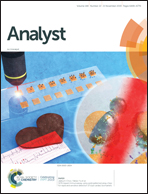A wavelength-resolved electrochemiluminescence resonance energy transfer ratiometric immunosensor for detection of cardiac troponin I
Abstract
In this study, a wavelength-resolved electrochemiluminescence resonance energy transfer (ECL-RET) ratiometric immunosensor from Au nanoparticle functionalized graphite-like carbon nitride nanosheets (Au-g-C3N4) to Au nanoclusters (Au NCs) has been constructed for the first time. At a working voltage of 0 to −1.2 V, Au-g-C3N4 showed a strong cathodic ECL emission with a peak at 460 nm, which overlapped well with the absorption spectra of Au NCs thus stimulating the fluorescence emission of Au NCs at 610 nm. Moreover, within this voltage range, the Au NCs showed no ECL signal; therefore, they would not interfere with the detection of the system. We used cardiac troponin I (cTnI) as an analytical model to construct a sandwich immunosensor based on the ECL-RET ratiometric strategy. By measuring the responses of the ECL460 nm/FL610 nm ratio at different cTnI concentrations, the sensitive detection of cTnI with a wide range of 50 fg mL−1 to 50 ng mL−1 and a low detection limit of 9.73 fg mL−1 can be achieved. This work enriches the wavelength-resolved ECL-RET system and provides an innovative reference for the development of more efficient and sensitive ECL-RET ratiometry.



 Please wait while we load your content...
Please wait while we load your content...